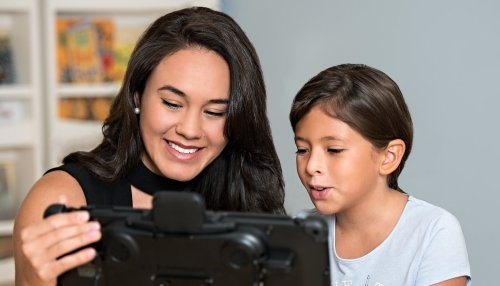“Bilingualism is the ability to communicate in more than one language and can be thought of as a continuum of language skills in which proficiency in any of the languages used may fluctuate over time and across social settings, conversational partners, and topics, among other variables” (Grosjean, 1989; Bialystok, 2001 on ASHA.org). Children who grow up speaking two or more languages often exhibit altered developmental patterns from children who hear and speak one language. It can be difficult to determine whether a bilingual child is experiencing difficulties with language learning due to the complexity of dual language acquisition, or due to a language disorder. This type of assessment is best handled by a bilingual speech-language pathologist, or by a speech-language pathologist with expertise in bilingual assessment and a qualified interpreter.
A speech-language pathologist with expertise in bilingual assessment can conduct a bilingual language assessment to determine if a client is demonstrating a true language disorder or a language difference. A language disorder is indicated when the client shows the same linguistic variations in all languages spoken. For example, a three year old child speaks about ten words in English and ten words in Spanish, and does not combine words in either language. This suggests a language disorder that is causing poor language development in both languages. A language difference is indicated when the child presents occasional linguistic variations. For example, the child may pronounce sounds differently, combine words into sentences that have minor grammatical errors, or use words in a manner that indicates s/he does not fully understand its meaning. These are some common language differences that are noted in children who learn to speak two languages. Over time, many language differences resolve without intervention. Language disorders, on the other hand, require therapy services.
An appropriate assessment of a bilingual learner includes gathering information about the individual through the use of culturally and linguistically appropriate assessment tools, methods, and measures. These include the use of case history, interview, questionnaires, language samples, observations, and/or criterion referenced tests. Some of these procedures are conducted one-on-one with the client. Some are conducted as part of a dynamic assessment, or one that is conducted in the client’s natural environment. Speech-language pathologists may need to make modifications to formal tests to make them more appropriate for the bilingual client.
While a bilingual speech-language pathologist who speaks the client’s language is often unavailable, an English-speaking speech-language pathologist can work with other team members to gather data necessary for differentially diagnosing a speech-language disorder. These team members may include the individual, an interpreter, translator, cultural broker, family member/caregiver, and/or other relevant individuals, such as school educators.
Upon the identification of a language disorder, the speech-language pathologist will create an intervention plan in the mode or modes of communication appropriate for the bilingual individual. This intervention plan may include a bilingual and/or a cross-linguistic approach to intervention. Although bilingualism is complex, individuals diagnosed with a language disorder have the capacity to learn two languages.
The Speech-Language Institute at Midwestern University offers bilingual (English/Spanish) assessment and intervention services. A professor with expertise in cultural and linguistic diversity will work with graduate student clinicians to assess and remediate each client’s unique language needs.

